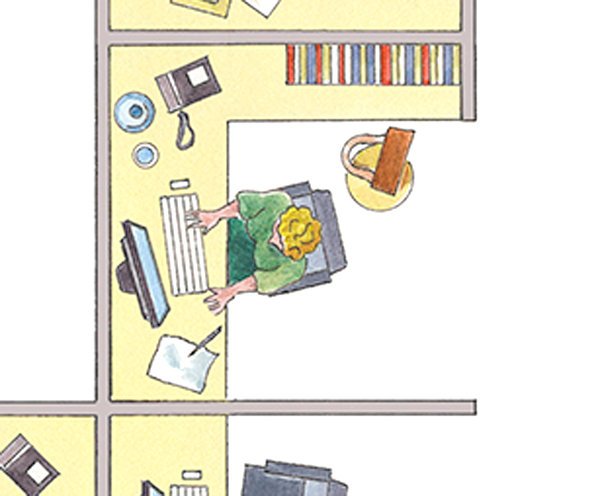|
Imagine yourself in a typing pool in the early 1960s, amid the clack-clack-clack-PING of dozens of Smith-Coronas. You’re out in the open, like a factory worker, with nowhere to hide from the raking gaze of the boss.
想象一下,如果你活在1960年代初,坐在一堆打字的人中间,周围满是斯密斯-科罗纳(Smith-Corona)牌打字机噼啪噼啪的声音。你就像工厂的工人一样,在敞开的空间里无遮无掩,在老板扫射的目光之下无所遁形。
Robert Propst, a designer for Herman Miller Research Corporation, wanted to liberate secretaries from that hell. In Europe, office designers promoted the idea of Bürolandschaft, or “office landscape” — privacy screens and office plants — and Propst borrowed it, introducing the Action Office II, a system of click-together desks and pop-up walls, in 1968. Hoping to bring democracy to the workplace, Propst had instead ushered in the cubicle, a billion-dollar industry and a metonym for drudgery.
赫尔曼·米勒研究公司(Herman Miller Research Corporation)的设计师罗伯特·普罗普斯特(Robert Propst),想要将秘书们从那样的惨境中解救出来。当时在欧洲,办公室设计师们已经在推广一种叫“Bürolandschaft”(意为“办公室景观”)的创意——用屏风和室内绿植来分隔私人空间。普罗普斯特借鉴了这个想法,在1968年推出了“第二代活动办公室”(Action Office II),那是一套组装办公桌以及能从桌面上展开的隔断。普罗普斯特本想要给办公室带来民主的气息,却开创了一套格子间办公室格局和一项价值上十亿美元的产业,并且让奴役有了更具体的形态。
In the ’70s, the designer Douglas Ball — inspired by Propst’s mobile walls — created another early cubicle system. “I went to see one of the first installations of this product,” he said. “I came out extremely depressed.” In trying to muffle sound, Ball had made the walls too high, isolating workers in their cells. Only by taking a chain saw to the cubicles, he said, could he remedy the problem.
70年代,受到普罗普斯特的移动隔断启发,设计师道格拉斯·鲍尔(Douglas Ball)创造出了另一种早期的格子间。鲍尔说:“这种产品最早开始安装的时候,我去看了一下,结果气急败坏地走了出来。”为了隔音,他把隔墙弄得太高,每个人都孤立地分隔在自己的小囚室里。他说,这个问题无法解决,只能用电锯把墙锯掉。

During the boom-bust cycle of the 1990s, the cube became the FEMA trailer of officeland; it could be slapped up during good times and knocked down in bad. By the late ’90s, a cube empire had risen in Western Michigan, where companies like Herman Miller, Haworth and Steelcase churned out acres of fuzzy walls.
在20世纪90年代那段由盛转衰的时期,在办公室里,这种格子间就成了联邦紧急事务管理处(FEMA)最好的宣传样板;在形势好的时候,它可以迅速组装起来,不好的时候,能一下子拆得干干净净。到了90年代后期,格子间产业王国渐渐在美国西密歇根地区崛起,在那里,赫尔曼·米勒、海沃氏(Haworth)、世楷(Steelcase)等公司迅速大量生产了那种贴了毛茸茸壁毯的隔板。
Meanwhile, Douglas Ball continued to rethink the cubicle, inventing a high-end model inspired by his Westfalia camper van in 2002 : “We have to give people a door and a clothes closet where they can hang up their leather jacket. We can use a lot of glass.” Herman Miller now sells Ball’s cruise-ship cubicle, but it’s a niche product. Meanwhile, cubedom is cheaper than ever: a refurbished telemarketing station costs about $200.
与此同时,道格拉斯·鲍尔则在不断改良隔断设计,并且在2002年受他的威斯法利(Westfalia)野营车启发,设计出了高端的办公室格子间:“我们要给人们做一扇门,还有一个衣橱,让他们挂皮衣。可以用大量的玻璃。”赫尔曼·米勒公司现在就在售卖鲍尔的这种游轮套间式格子间,不过它只是一种小众产品。而另一方面,普通办公格子间却变得越来越便宜:翻新一个电话推销办公区域只需要200美元。
“Not all organizations are intelligent and progressive,” Propst said two years before he died in 2000. “Lots are run by crass people. They make little, bitty cubicles and stuff people in them. Barren, rathole places.” He spent his last years apologizing for his utopia.
“并不是所有的企业都那么聪明和追求进步,”普罗普斯特在2000年去世,在去世前两年他曾这样说道:“有很多都是一些粗鲁的人在经营。他们只是弄一些又小又窄的格子间,然后把人往里面塞。都是些像老鼠窝一样简陋的地方。”在他人生的暮年,他一直在为了自己设想的乌托邦致歉。
CUBE ART
格子间艺术
Bill Taylor, a data manager in Chapel Hill, N.C., painstakingly reproduces great works of art — Degas, Hopper, Banksy — on the whiteboard in his cubicle.
北卡罗莱纳州教堂山的数据管理员比尔·泰勒(Bill Taylor)在他格子间的白板墙上煞费苦心地临摹德加(Degas)、霍普(Hopper)、班克西(Banksy)等人的伟大艺术作品。
What’s the most challenging piece you’ve ever produced? I tried to recreate this scene of a house on a hill, painted all in triangles. As soon as I started it, I knew it would take three months. I thought, If somebody smudges this, I am going to lose my mind.
你画过最有难度的画是哪一幅?我试过重画一幅山顶上有一幢屋子的风景画,全部用三角形拼成。从一开始画的时候我就知道,这得花三个月。我想,如果有人把这个弄花的话,我会疯掉的。
But at some point you erase each work? Yup. I leave it up for a few days. And then, That’s that, and I wipe it all off.
不过到了某个时候,你不是又把所有作品都抹掉了吗?对。我让它保留了几天。然后,觉得也就这样了,我就把它全抹掉了。
In some ways, the cubicle has been your muse. Yeah. I wanted to find my way back to art, and this has given me a way to practice every day and brighten up the office a little bit.
某种意义上,这种格子间是你的灵感来源。
是的。我想要找回对艺术的感觉,而这东西给了我每天实践的机会,给办公室添加一点亮色。
本文最初发表于2012年6月24日。
翻译:邵智杰
|
- VOA 英语教学节目
-
- 经典英语在线训练资源
-
|

